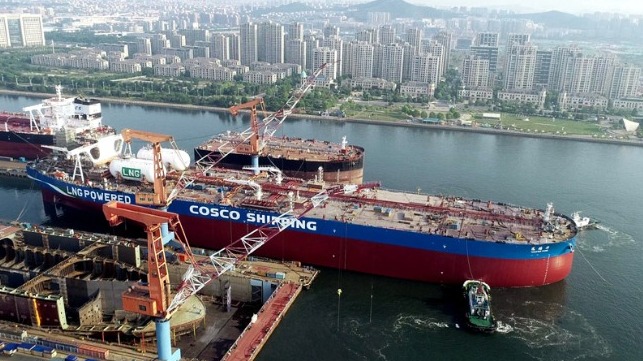First LNG Dual-Fuel VLCC Starts Sea Trials in China

The first LNG dual-fuel VLCC completed construction and has begun sea trials before its entry into service. Built in China at the China State Shipbuilding Company’s Dalian Shipbuilding Industry yard, the vessel meets next generation safety and environmental regulations and is part of the increasing effort by shipowners to seed the adoption of LNG to meet near-term environmental regulations.
According to DSIC, the vessel incorporates several design enhancements to increase its efficiency and safety. The 318,000 dwt tanker was ordered in 2017 as a conventional VLCC, but a year ago COSCO amended the order to convert the vessel to LNG as its main fuel, supplemented by oil. The ship has a total length of about 1,091 feet, a molded width of 197 feet, a molded depth of 100 feet, a design draft of 67 feet, and a service speed of 15 knots.
The gas system adopts the design of a single unit and a single pipe, which according to DSIC significantly enhances the safety of gas use and enhances the flexibility for the shipowner. The main engine, a WINGD-low pressure, and generator are equipped with LPSCR, helping the vessel to meet the requirements of EEDI PHASE III, and NOx Tier III requirements for nitrogen oxide emission.
The ship adopts a straight bow design, and the stern is also optimized. With a large-size 35-foot diameter propeller, it achieves greater energy efficiency. In gas mode, the ship's endurance can reach 12,000 nautical miles, with a combined endurance for fuel and gas of 24,000 nautical miles. During a typical voyage, the daily gas consumption is about 60 tons of LNG. The daily fuel consumption is about 74 tons, making the design energy efficiency index (EEDI) about is 36 percent lower than the baseline value.

that matters most
Get the latest maritime news delivered to your inbox daily.
The ship’s LNG storage system adopts a C -type storage tank design, with an LNG filling station on the port and port sides, with a filling rate of 1500 cubic meters per hour. The storage tanks, which are deck mounted in front of the deckhouse, are made of 9Ni steel and provides the vessel with a range to complete one roundtrip voyage to the Middle East and back to Asia.
In 2020, French energy major Total announced that it had signed an agreement to charter its first two LNG-powered VLCCs due to enter service in 2022. The vessels are part of the continuing trend to expand the use of LNG into more sectors of shipping. DNV recently indicated that approximately 12 percent of the global order book uses alternative fuel with LNG being the favored option for large, ocean-going vessels. DNV’s data says that there are currently approximately 220 LNG-fueled vessels in operation worldwide, with another 354 on order.
